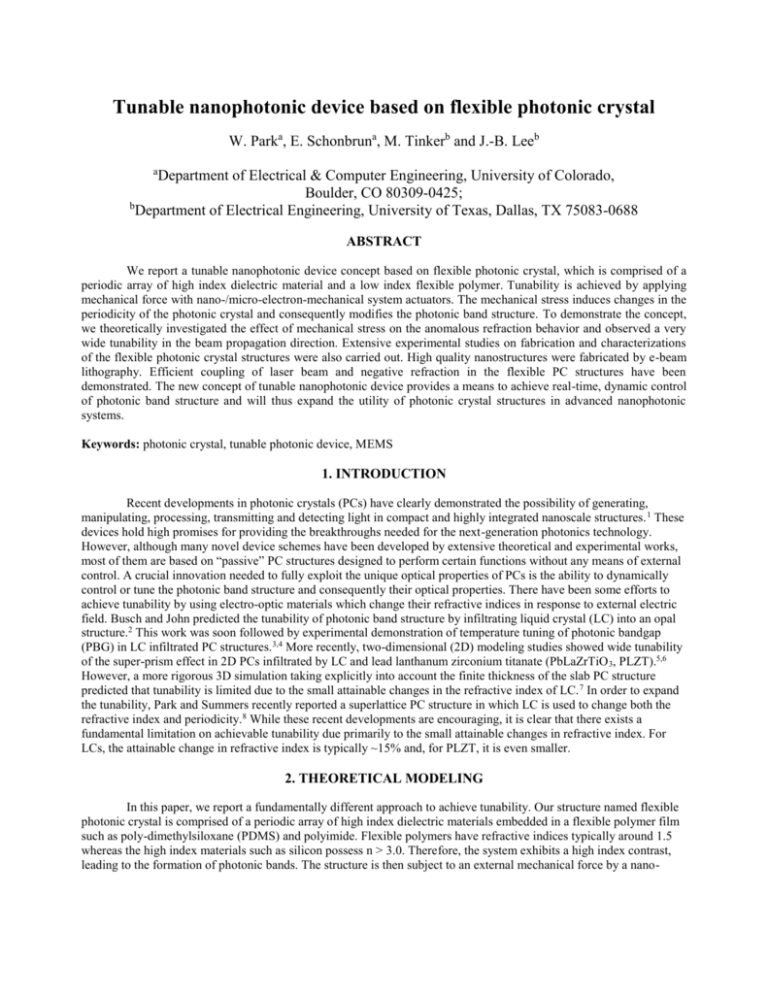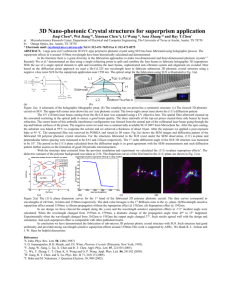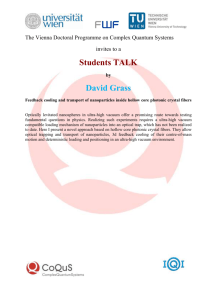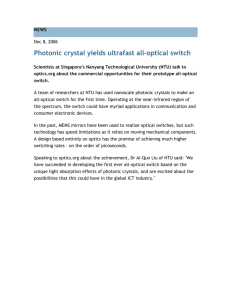Paper Title - Micro/Nano Devices & Systems Lab
advertisement

Tunable nanophotonic device based on flexible photonic crystal W. Parka, E. Schonbruna, M. Tinkerb and J.-B. Leeb a Department of Electrical & Computer Engineering, University of Colorado, Boulder, CO 80309-0425; b Department of Electrical Engineering, University of Texas, Dallas, TX 75083-0688 ABSTRACT We report a tunable nanophotonic device concept based on flexible photonic crystal, which is comprised of a periodic array of high index dielectric material and a low index flexible polymer. Tunability is achieved by applying mechanical force with nano-/micro-electron-mechanical system actuators. The mechanical stress induces changes in the periodicity of the photonic crystal and consequently modifies the photonic band structure. To demonstrate the concept, we theoretically investigated the effect of mechanical stress on the anomalous refraction behavior and observed a very wide tunability in the beam propagation direction. Extensive experimental studies on fabrication and characterizations of the flexible photonic crystal structures were also carried out. High quality nanostructures were fabricated by e-beam lithography. Efficient coupling of laser beam and negative refraction in the flexible PC structures have been demonstrated. The new concept of tunable nanophotonic device provides a means to achieve real-time, dynamic control of photonic band structure and will thus expand the utility of photonic crystal structures in advanced nanophotonic systems. Keywords: photonic crystal, tunable photonic device, MEMS 1. INTRODUCTION Recent developments in photonic crystals (PCs) have clearly demonstrated the possibility of generating, manipulating, processing, transmitting and detecting light in compact and highly integrated nanoscale structures. 1 These devices hold high promises for providing the breakthroughs needed for the next-generation photonics technology. However, although many novel device schemes have been developed by extensive theoretical and experimental works, most of them are based on “passive” PC structures designed to perform certain functions without any means of external control. A crucial innovation needed to fully exploit the unique optical properties of PCs is the ability to dynamically control or tune the photonic band structure and consequently their optical properties. There have been some efforts to achieve tunability by using electro-optic materials which change their refractive indices in response to external electric field. Busch and John predicted the tunability of photonic band structure by infiltrating liquid crystal (LC) into an opal structure.2 This work was soon followed by experimental demonstration of temperature tuning of photonic bandgap (PBG) in LC infiltrated PC structures.3,4 More recently, two-dimensional (2D) modeling studies showed wide tunability of the super-prism effect in 2D PCs infiltrated by LC and lead lanthanum zirconium titanate (PbLaZrTiO 3, PLZT).5,6 However, a more rigorous 3D simulation taking explicitly into account the finite thickness of the slab PC structure predicted that tunability is limited due to the small attainable changes in the refractive index of LC. 7 In order to expand the tunability, Park and Summers recently reported a superlattice PC structure in which LC is used to change both the refractive index and periodicity.8 While these recent developments are encouraging, it is clear that there exists a fundamental limitation on achievable tunability due primarily to the small attainable changes in refractive index. For LCs, the attainable change in refractive index is typically ~15% and, for PLZT, it is even smaller. 2. THEORETICAL MODELING In this paper, we report a fundamentally different approach to achieve tunability. Our structure named flexible photonic crystal is comprised of a periodic array of high index dielectric materials embedded in a flexible polymer film such as poly-dimethylsiloxane (PDMS) and polyimide. Flexible polymers have refractive indices typically around 1.5 whereas the high index materials such as silicon possess n > 3.0. Therefore, the system exhibits a high index contrast, leading to the formation of photonic bands. The structure is then subject to an external mechanical force by a nano- /micro-electro-mechanical system (NEMS/MEMS) actuator that stretches and releases the flexible polymer. Application of mechanical force results in physical changes in crystal structure to which the photonic bands are extremely sensitive. This approach can therefore produce much greater tunability than what is possible in the structures involving electrooptic materials. The device concept is schematically shown in Figure 1. V V Fig. 1. Schematic diagram of flexible photonic crystal structure controlled by a pair of NEMS/MEMS actuators. The flexible photonic crystal is composed of Si pillars (white cylinders) embedded in a flexible polymer film. To demonstrate the tunability achievable in flexible PC, we performed theoretical investigations on the effect of mechanical force on optical beam propagation. PCs are known to exhibit anomalous refraction behavior due to the highly nonlinear and anisotropic dispersion characteristics. This unique phenomenon was first discovered by Lin et al. 9 at microwave wavelengths and soon after by Kosaka et al. 10 at optical wavelengths. Additionally, this phenomenon was also predicted by Park and Summers11 in 2D PC slab waveguides with finite thickness, which represent the realistic structures compatible with conventional lithography-based fabrication technique. For a Si 2D slab PC, a refraction angle up to 70o was predicted for incident angles less than 7o, and frequency components differing only by 3% were separated by 15o, much larger than what’s achievable with conventional gratings. 11 These effects have recently been demonstrated experimentally in a GaAs-based 2D slab PC structure by Wu et al.12 For numerical modeling, we used the plane-wave method13 and finite-difference time-domain (FDTD) method to calculate photonic band structures, equi-frequency dispersion curves and refraction angles and also to directly visualize the propagation of an optical beam. The test structure we modeled is comprised of a triangular array of silicon pillars embedded in PDMS. The dielectric constants of silicon and PDMS were set to be 12 and 2.4, respectively. The pillar diameter was 0.6a where a is the lattice constant, i.e. the center-to-center distance between two adjacent pillars. The structure was discretized into a numerical grid with 15-32 points per lattice constant. For the calculation of photonic band structures and equi-frequency dispersion surfaces, the computational domain contained only one unit cell with periodic boundary conditions. For beam propagation simulations by the FDTD method, we modeled a large structure enclosed by perfectly matched layer absorbing boundary condition. 14 Our test structure was found to exhibit anomalous refraction behavior at a normalized frequency (a/2c) of 0.39. The equi-frequency dispersion curve for the unstressed triangular PC (outer curve) shown in Figure 2(b) has a star-like shape, exhibiting sharp inflection points along the high symmetry directions, -M and -K. These inflection points represent regions where strong variation in the light propagation direction is expected. We then proceeded to model the system under mechanical stress, which lowers the crystal symmetry and consequently yields a strong modification of the dispersion surface. When the PC is uniformly stretched along the -K direction, as indicated in Figure 2(a), the dispersion curve becomes consequently distorted as shown in Figure 2(b). It is evident that the dispersion curves are extremely sensitive to the mechanical deformation, especially along the horizontal direction (-M direction) normal to the direction of mechanical force. As shown, the dispersion curves along the -M direction become flattened significantly as the PC is stretched along the -K direction. This results in a very large change in the refraction behavior for optical beams propagating near the -M direction. Since the group velocity is defined as the gradient of dispersion surface in k-space, we can estimate the refraction angles from the curvature of the equi-frequency dispersion curve.11 The calculated refraction angles are shown in Figure 3(a). All three cases exhibit unconventional refraction behaviors, deviating strongly from the Snell’s law. The perfect triangular lattice exhibits giant negative refraction in which the refraction angle reaches 70o for an incident angle as small as 5o. As the PC is mechanically stretched, however, due to the flattening of the dispersion curve, the refraction angle decreases dramatically and varies only little as the incident angle is changed. Furthermore, for the case of 10% stretching, it no longer exhibits negative refraction but the normal refraction behavior. The differences in refraction angles between the perfect triangular lattice and 10% stretched crystal reach more than 75o for a fairly wide range of incident angles between 5 and 15o. This analysis based on the equi-frequency dispersion curves was further confirmed by the beam propagation simulation using the FDTD method. The real space simulation by FDTD shows the actual beam path from which the refraction angles can be measured directly. Our FDTD simulations yielded the results that are consistent with the analysis based on the equifrequency dispersion curves. Figure 3(b) shows two simulations done for perfect triangular lattice and 10% stretched crystal with a gaussian beam incident with an angle of 12 o. The incident gaussian beam was launched from the bottom of the computational domain and the flexible PC structure was placed in the upper region with the same orientation shown in Figure 2(a). The large difference in refraction angles between the two cases is clearly shown. -M direction Stretching along -K direction Refracted beam M K r Incident beam i (a) (b) Fig. 2 (a) Schematic diagram of triangular PC structure of Si pillars (dark circles) in a PDMS film (light background). (b) Dispersion curves of perfectly triangular (outer curve), 5% stretched (middle curve) and 10% stretched (inner curve) PCs calculated for a normalized frequency of 0.39. The hexagon is the first Brillouin zone boundary. 10% Elongation along -K Refraction Angle (degree) 20 0 5% Elongation along -K -20 -40 No Elongation -60 -80 0 5 10 15 20 25 30 Incident Angle (degree) (a) (b) Fig. 3 (a) Refraction angles calculated from the dispersion curves in Figure 2(b). Angles are measured from the -M direction, as indicated in Figure 2(a). (b) FDTD simulations showing the refraction of a gaussian beam incident on the perfectly triangular PC (upper panel) and 10% stretched PC (lower panel). The incident beam was launched from the bottom and the flexible PC structures were placed in the upper region of the computational domain with the same orientation shown in Figure 2(a). The incident angle was 12 o for both cases. It is emphasized that such a large change in refraction angle is achieved with a very small mechanical deformation. When designed for the communication wavelength of 1.54 m, the pillar-to-pillar distance, a, is 0.6 m and a 10% change is a mere 60 nm per unit cell. A larger stretching could, of course, induce an even greater change in refraction behavior but one must also consider fatigue and elasticity limit of the polymer. We performed finite element modeling and confirmed that, up to 10% stretching, the polymer would be stretched uniformly with its displacement linearly proportional to the applied mechanical force. Another important consideration that needs to be made is the Poisson ratio of the flexible polymer. PDMS has a very large value of Poisson ratio approaching nearly 0.5. This means that a 10% stretching along the -K direction will result in a simultaneous reduction in film thickness by 5% or 15 nm in our test structure. Fortunately, the photonic band structure is not very sensitive to the slab thickness, as it concerns primarily with the light propagation along the slab. Thus, such small changes in thickness will not significantly affect the light propagation characteristics. Finally, we point out that the tunability of the anomalous refraction behavior is not limited to one particular direction and similar behaviors have also been observed for stretching along the -M direction. This result demonstrates that mechanical tuning of PCs’ optical properties is a broadly applicable concept. 3. FABRICATION AND CHARACTERIZATIONS The actual dimensions of the fabricated photonic crystal device are shown in Figure 4(a). Slight deviations from the perfect triangular lattice occurred due to the accuracy of the e-beam tool. The layout of the entire photonic crystal device is shown in Figure 4(b). The test structures have 10 rows with 100 silicon pillars per each row. Thus, the photonic crystal structures have a total width of 5.14m and length of 62.87m as measured from the center of the silicon pillars. The polyimide layer used to support the pillars has been designed to be 4.0m larger than the width of the photonic crystal structures in order to provide plenty of tolerance for aligning the polyimide mask to the silicon pillars. Consequently, the top of the polyimide is situated approximately 2.0m above the top of the silicon pillar matrix and the bottom of the polyimide is situated approximately 2.0m below the bottom of the matrix. Diameter = 380 nm Vertical lattice dimension = 654 nm Horizontal lattice dimension = 635 nm (a) polyimide Silicon pillar matrix (b) Fig. 4 (a) Dimensions of the unit cell. (b) The entire photonic crystal structure layout which contains 10 rows with 100 pillars per each row. Cross sectional schematics of the process are shown in Fig. 5. The process can be broken into four major subcategories: initial thermal oxide growth and polysilicon deposition, the first level polysilicon mask level and etch, the deposition of the polyimide layer, and the second level polyimide mask level and etch. The original silicon wafers were (100) oriented 3 inch wafers highly doped with phosphorus to attain resistivities between 0.008 to 0.018 ohms-cm. These wafers were then oxidized using a wet oxidation process to a thickness of 3.0m. Undoped polysilicon layer was then deposited on top of the oxide to a thickness of 0.35m by LPCVD. The various process steps were then taken to form the photonic crystal polysilicon mask level and etch the resultant polysilicon mask. A bi-layer copolymer photoresist stack was used to form the photoresist mask for the silicon pillar matrix which was subsequently exposed and developed to form the desired photonic crystal pattern. Next, Cr was evaporated to a thickness of 10nm and the Cr mask is formed by a subsequent lift-off process. The silicon pillars are then formed by using a silicon RIE etch using a CF4/8.75%O2 plasma. The Cr caps are then finally removed using a highly selective Cr etch. Polyimide is then deposited in top of the Si PC structure. First an adhesion promoter is applied to the surface followed by the deposition of polyimide by spin coating. The polyimide is then baked in a high temperature. The resulting polyimide is approximately 400nm thick. Various process steps were then taken to form the polyimide mask and etch the polyimide in order to generate the polyimide layer supporting the silicon pillars. The polyimide was first patterned by depositing, exposing and developing a positive optical photoresist. The Cr evaporation and lift-off processes were then used to form the metal mask. The polyimide layer supporting the photonic crystal device is then formed by using O2 RIE etch. Thermal Oxidation and LPCVD Deposition of Polysilicon Cr Lift-Off Cr mask Polysilicon thermal oxide Polyimide Polyimide Spin-On Polysilicon Si Reactive Ion Etch Fig. 5 Schematic diagram of the process flow for the fabrication of flexible PC structures (a) (b) (c) (d) (e) Fig. 6 SEM photomicrographs: (a) anisotropically dry etched triangular array of circular silicon pillars with diameters in the range of 500 nm ~ 2.5 m; (b) close-up view; (c) a triangular array of circular silicon pillar embedded in a patterned polyimide; (d) angled silicon waveguide; (e) air suspended FPC. The ultimate microstrutures generated at various stages of the process including the final structure are shown in Fig 6. Figure 6 (a) shows an SEM photomicrograph of an etched test silicon pillar array with various dimensions. Figure 6 (b) shows a close-up image of the silicon pillar array which has structural aspect ratio of approximately 1:1. Figure 6 (c) shows an SEM image of silicon pillar array embedded in the spin coated polyimide layer. In addition to the silicon pillar array, poly-silicon is also patterned to provide a waveguide to the FPC for easy beam coupling. Figure 6 (d) shows an SEM photomicrograph of the angled silicon waveguide with a block of silicon pattern for beam coupling testing. In order to realize MEMS actuated FPC, we have fabricated suspended FPC (Figure 6-e). In the fabrication of the suspended FPC, oxide layer underneath the patterned FPC was selectively etched away. Extensive fabrication characterization was carried out to find the optimum process sequence for the air suspended FPC. Currently, integration of such an air suspended FPC with the silicon waveguide and recently developed nanoscale thermal actuators are under way. The fabricated structures went through extensive optical characterizations. We used fiber-coupled lasers emitting at 1550 and 1310 nm as sources and an InSb detector and a vidicon camera as detectors. For characterization purposes, the flexible PC structures were fabricated along with a Si ridge waveguide through which a probe laser beam is delivered to the flexible PC structure. Several identical flexible PC structures were fabricated with input waveguides making different incident angles, so that the refractive properties may be investigated as a function of incident angles. An example of the input waveguide and flexible PC structure co-fabricated on a single wafer is shown in Fig. 6(d). The laser beam from the source was first fed through a polarization controlling paddle (PCP) and then butt-coupled to the ridge waveguides etched onto the wafer. The PCP allows us to illuminate the device with either TE or TM polarized light which behave very differently in the photonic crystal region. The device’s refractive properties were directly measured by imaging both the light scattered out of the device, and light transmitted through the device. Due to structural imperfections and coupling losses, light leaks out of the plane of the wafer and is captured by a microscope on a translation stage and recorded by a vidicon camera. If the losses inside the photonic crystal matrix are large enough, a ray path inside the structure can be resolved by imaging the scattering from above. Ideally, only a small amount of light will be lost, and refraction inside the photonic crystal is deduced by the location of the transmitted spot where it hits the deflection block placed on the exit side of the flexible PC structure. The measurement setup is schematically shown in Fig. 7. Fig. 7. Schematic diagram of the optical characterization setup. Laser beam Si input waveguide guided thru inclined 6o from free space the Si block horizontal region exiting = 1.54 m Unpatterned Si block Si input waveguide inclined 6o from horizontal = 1.54 m FPC Input beam from the 6o inclined input WG was refracted back upward Negative refraction Fig. 8 The vidicon camera images showing the out-of-plane scattered light for (a) a reference sample (free space) and (b) flexible PC structure. In both cases, input Si ridge waveguide and deflection block are co-fabricated on the input and exit sides of the sample, respectively. The input waveguides make an incident angle of 6 o in both cases. As shown from the images by the vidicon camera in Fig. 8, the small leakage through the side walls of the Si input waveguide could be seen, showing the path of the input laser beam. As the input beam hits the flexible PC structure, a larger amount of light is scattered out of the plane, forming a bright spot. In Fig. 8(a), we show the reference sample in which a region of free space is fabricated in place of the flexible PC structure. The size and dimensions of the free space region is identical to the flexible PC structure and an unpatterned Si block is placed to detect the beam leaving the free space region. This serves as the reference sample and clearly shows the path of the input beam through the free space region and is partially coupled through the Si block. The bright spot on the right side is the guided beam exiting the Si block. The dark image between the two bright spots on the input and exit sides of the Si block clearly demonstrates that the probe laser beam is coupled in and guided through the Si block. We then proceeded with the same measurements with the flexible PC structure. The geometry is identical to the reference sample shown in Fig. 8(a), expect that we now have a real flexible PC structure in place of the free space region. As shown in Fig. 8(b), the beam path through the input waveguide was once again observed. The difference in this case, however, was that the flexible PC structure caused the beam refracted back upwards, clearly showing negative refraction. To our knowledge, this is the first observation of negative refraction in Si-based PC structure. We are currently investigating the movable structure and expect to demonstrate dynamic beam steering in the near future. 4. SUMMARY In summary, we reported a tunable photonic crystal structure, the flexible photonic crystal, that can be controlled by a NEMS/MEMS actuator. Due to the sensitivity of photonic band structure to the physical changes in crystal structure, a very large tunability can be achieved. Also, the device structure is compatible with the lithographic fabrication technique and is therefore perfectly fitting for monolithic integration with other semiconductor-based optoelectronic devices. To demonstrate the tunability, we carried out theoretical investigations on the effect of mechanical stress on anomalous refraction. A 10% stretching along the -K direction yielded a change in refraction angle as large as 75o, clearly showing the potential for optical beam steering device. By providing real-time control over the unique optical properties of PC structures, the flexible photonic crystal will serve as a platform for nano-scale photonic devices such as optical switches, routers and modulators. We have also made significant progress on the experimental demonstration of flexible PC concept. High quality flexible PC structures were fabricated by e-beam lithography and anisotropic etching processes. The formation of triangularly symmetric PC structures with and without flexible polymer layers were directly observed with SEM micrographs. We have also demonstrated successful release of the flexible PC structure from the underlying substrate, making good progress toward dynamically movable structures. The fabricated PC structures went through extensive optical characterizations. We have demonstrated that the laser beam can effectively coupled into the PC structures. And for the first time, we have experimentally observed negative refraction occurring in the Si-based PC structures. 5. ACKNOWLEDGEMENT The authors gratefully acknowledge the financial support from the National Science Foundation through grant ECS-0304442. 6. REFERENCES 1 2 3 4 5 6 7 8 9 See, for example, S. G. Johnson and J. D. Joannopoulos, “Photonic crystals : the road from theory to practice”, Kluwer, Boston, 2001. K. Busch and S. John, Phys. Rev. Lett. 83, 967, (1999) K. Yoshino, Y. Shinoda, Y. Kawagishi, K. Nakayama and M. Ozaki, Appl. Phys. Lett. 75, 932, (1999) S. W. Leonard, J. P. Mondia, H. M. van Driel, O. Toader, S. John, K. Busch, A. Birmer, U. Gosele and V. Lehmann, Phys. Rev. B 61, R2389, (2000) D. Scrymgeour, N. Malkova, S. Kim and V. Gopalan, Appl. Phys. Lett. 82, 3176 (2003) S. Xiong and H. Fukshima, J. Appl. Phys. 94, 1286, (2003) C. J. Summers, C. W. Neff and W. Park, J. Nonlinear Opt. Phys. Mater. 12, 587 (2003) W. Park and C. J. Summers, Appl. Phys. Lett. 84, 2013 (2004) S.-Y. Lin, V. M. Hietala, L. Wang and E. D. Jones, Opt. Lett. 21, 1771 (1996) 10 11 12 13 14 H. Kosaka, T. Kawashima, A. Tomina, M. Notomi, T. Tamamura, T. Sato and S. Kawakami, Phys. Rev. B 58, 10096 (1998) W. Park and C. J. Summers, Opt. Lett. 27, 1397 (2002) L. Wu, M. Mazilu and T. F. Krauss, J. Lightwave Technol. 21, 561 (2003) S. G. Johnson and J. D. Joannopoulos, Opt. Express 8, 173 (2001) C. T. Chan, Q. L. Yu and K. M. Ho, Phys. Rev. B 51, 16635 (1995)







